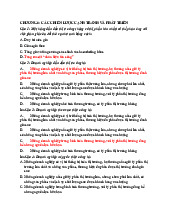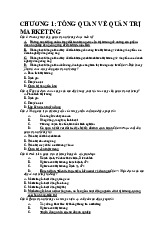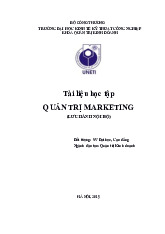









Preview text:
Value Chain Starbucks wrkshp Introduction
Value chain analysis is useful for new producers, including poor producers and poor countries
trying to enter the global market in a way that will provide for sustainable income growth. The
value chain analysis also is useful as an analytical tool in understanding environmental policy
which provides for the efficient allocation of resources within the domestic economy. Company Background
Starbucks started in 1971 when three academics: English teacher Jerry Baldwin, history teacher
Zev Siegel, and writer Gordon Bowker, opened a store called Starbucks Coffee, Tea, and Spice in
Seattle. These three partners shared a love for fine coffees and exotic teas and believed they
could build a clientele in Seattle much like that in the San Francisco. Each invested $1,350 and
borrowed $5,000 from a bank to open the Pikes Place store. The company began its first
operations by providing coffee to restaurants and espresso bars, by the mid-80s, the director of
retail operations and marketing, Howard Schultz introduced the idea of coffee house to the company’s founders.
In 1991, Starbucks began to gain ground and by end of the decade, the company had grown
significantly. The 1990s was considered to be the company’s turning point toward becoming a
giant company. However, it was at the beginning of the millennium that the Starbucks through
the introduction of “Starbucks Experience” that its “miracle” occurred. The coffee store grew in
leaps since the year 2000. On the first half of this decade, the company expanded in the domestic
and international markets (Garza, 2012). Vision
The vision of Starbucks is to be known as one of the world’s great companies by leading with
courage, passion and integrity. Creating one of the world’s best brands by maintaining an
uncompromising commitment to the quality of coffee. Creating a good work environment and
believing in the power of people, maintaining commitment to the environment and community (Starbucks, 2010). 1 The Value Chain
Michael Porter (1998) states that getting competitive advantage can be achieved through analysis
of the company’s value chain. A company’s value chain is “a system of interdependent activities
which are connected by linkages”. The value chain is included in the company’s larger stream of
activities, which are connected when one activity affects the effectiveness or costs of the other
activities. Companies can reach competitive advantage when value chain is optimized by
coordinating the activities to create a value for its products or services which exceeds the costs of
performing the value activities (Porter 1998). Furthermore, a company can create additional
value for its products or services (and increase the prices of the same) without necessarily
increasing the costs of production or cost of services, whereby customers are still willing to pay for the added value. Types of Value Chain
There are two types of value chain, the producer-driven chain and the buyer-driven chain.
Gereffi, 1996 made the useful distinction between the two types of value chains, where one
describes the role played by a buyer at the apex of the chain and the other describes the role of producers in the chain.
Buyer-driven chains are characteristic of labor-intensive industries such as footwear, clothing,
furniture and toys while Producer-driven chains are characteristics whereby producers take the
responsibility for assisting the efficiency of suppliers and customers. In recent work, Gereffi has
pointed out that producer-driven chains are likely to be more characterized by foreign direct
investment (FDI) than the buyer-driven chains (Gereffi, 1999). He also states that each of these
types of value chain is associated with different production systems.
Producer-driven commodity chain is that in which large, transnational, manufacturers play the
main role in coordinating production networks (including their backward and forward linkages).
It is a characteristic of capital- and technology-intensive industries like automobiles, aircraft,
computers, large machineries and semiconductors.
Buyer-driven commodity chain refers to those industries in which large marketers, retailers and
branded manufacturers play the major role in setting up production networks in several exporting
countries, located in the third world. This type of trade-led industrialization is common in labor- 2
intensive industries, consumer goods industries. Production is mostly carried out by tiered
networks of third world contractors who make finished goods for foreign buyers. The
specifications are supplied by large retailers or marketers who order the goods.
Producer- and buyer-driven chains compared
Producer-Driven Commodity Buyer-Driven Chains Commodity Chains Drivers of Global Industrial Capital Commercial Capital Commodity Chains Core Competencies Research & Development; Design; Marketing Production Barriers to Entry Economies of Scale Economies of Scope Economic Sectors Consumer Durables Consumer Non-durables Intermediate Goods Capital Goods Typical Industries Automobiles; Computers; Apparel; Footwear; Toys Aircraft Ownership of Transnational Firms Local Firms, Manufacturing Firms predominantly in developing countries Main Network Links Investment-based Trade-based Predominant Network Vertical Horizontal Structure Source: Gereffi, 1999b
A company’s value chain system can be grouped into two categories: 3
The primary activities, which involves the physical creation of products, marketing and delivery
system, and the after sale service and;
The secondary or support activities, whereby the company’s infrastructure and inputs allow the
primary activities to occur (Porter 1998).
The value chain system is analyzed so as to aid in the development of strategic goal and to gain
competitive or increase competitive edge in the marketplace.
Illustration of The Value Chain
Source: The value chain (Porter, 1985) 4 Primary Activities INBOUND LOGISTICS
Starbucks inbound logistics involves company agents choosing coffee bean producers mainly in
African continent, communicating the standards related to the quality of coffee beans and
establishing strategic relationships with suppliers as well as organizing the supply-chain
management. Starts from the farm to exporting, broker, finally to packaging (Clark, 2007).
Farm: Coffee Bean starts at the farm on coffee trees. It takes about one to three years for the trees
to bear coffee "cherries". Then the farmer harvests the coffee trees to get cherries. After which
coffee mills will be used in the processing of the product from cherry to bean.
Exporter: The coffee export process varies depending on the origin country and buyer. In some
countries, beans were exported through government coffee boards while in other countries,
private exporters are used (Clark, 2007).
Broker: The broker is the importer of the coffee bean. After the beans have been shipped to the
import country, it will be visually inspected and taste-tested for quality, this process is called
"cupping". After passing inspection, coffee will be stored in warehouses or shipped to roasting warehouse.
Roasting warehouse: When coffee beans get to the roasting warehouse, the beans are roasted
until they attain their characteristic color and aroma, and then cooled. After cooling, it will
blended to balance the flavors and strengths.
Packaging manufacture: This is where the packaging of the coffee beans takes place OPERATIONS
The operations of Starbucks are conducted in more than 50 countries in two ways: direct
operation of the stores by the company and licensing operation. Presently, there are 8870
company-operated stores globally, and 8139 stores operate on the basis of licensing (Starbucks
Company Profile, online, 2011). 5 OUTBOUND LOGISTICS
The outbound logistics for Starbucks are in three ways:
Retail business organization: this involves selling of its products through its stores without any intermediates.
Specialty sales and marketing: this involves selling their product to major restaurants, United
Airlines and other specialty accounts not falling under the retail business customer.
Direct response: This involves handling order from the internet or the mails and delivering.
However, recently some Starbucks products such as 3-in-1 coffees in sachets are being sold in some leading supermarkets. MARKETING AND SALES
Starbucks does not quite invest in marketing instead it relies on the word-of-mouth achieved
through the high quality of its products and high level of customer services. However, occasional
marketing activities done by the company involves sampling of new products which is mostly
conducted within areas close to the stores. SERVICE
Providing superior level of customer services is one of the main objectives of Starbucks and it is
driven from the mission statement of the company. The company staffs are encouraged to go
greater lengths in order to ensure high level of customer satisfaction. Support Activities INFRASTRUCTURE
Starbucks infrastructure includes a range of support activities such as “management, planning,
finance, accounting, legal support and government relations that are required to support the work
of the whole value-chain” (Hitt et al, 2009). HUMAN RESOURCE MANAGEMENT
The workforce is seen to be the most valuable resource for Starbucks. Starbucks has high
commitment to investing in its employees, which they feel is their greatest competitive 6
advantage. The Company with about 142,000 employees globally in year 2009 (Hoover, 2010),
values its employees and considers them as important as stakeholders in the business. Starbucks’
management believes that when all needs of employees are met with adequately, they will
provide quality services. The Company’s leaders like its CEO Schultz believe that employees
should feel appreciated. Compensation plans like performance bonuses and employee stock
ownership helps in retention of employees also emphasizing an open-door policy with management.
A wide range of training and development programs are available for the staffs which can
motivate them, including tangible and intangible incentives. Specifically, in the UK Starbucks’
staffs are entitled to free drinks during the shift. TECHNOLOGY DEVELOPMENT
The company relies on technology for cost-saving purposes, as well as ensuring the consistency
products quality and offering a high level of customer experience. An instance is with the
introduction of computerized coffee roasters, the consistency in the taste of Starbucks coffee was
ensured which has contributed to the level of customer retention.
From a technological standpoint, Starbucks have both internal and external issues to deal with.
External issues regarding product development and improvement, patenting and research &
development can be mainly a supplier based concern. Though, majority of the burden is on suppliers. PROCUREMENT
This is the purchasing of items that are needed for the production of final products or services.
This would be coffee beans and raw food items for the company, as well as fixed assets such as
buildings, machinery and so on.
Importance of Value Chain 7
There are three main reasons why value chain analysis is important in this time of rapid globalization.
With the growing rate of division of labor and the global dispersion of the production,
systemic competitiveness has become important. Value chain analysis helps in
understanding the scope for systemic competitiveness. Analysis and identification of core
competences leads the firm to outsource those functions that has no distinctive
competencies. Mapping out the flow of inputs, goods and services in the production chain
allows the firm to determine who and what plays the important role in its success.
Efficiency in production is just a necessary condition for successful penetration of
global markets. Value chain analysis is important because it helps in understanding the
advantages and disadvantages of organizations and countries specializing in
production other than services, and the way in which producers are linked to
final markets which may aid their ability to gain from participating in global markets.
Entry into global market allows for sustainable income growth, making the best use of
globalization requires an understanding of some dynamic factors within the entire value
chain. It ensures that the chain analyst treats the entire cycle of production to final
markets. This makes the analyst to consider not only the efficiency of the link of
production in the chain, but also those factors that determine the participation of
particular groups of producers in final markets.
Conclusion and Recommendation 8
In all, Starbucks has maintained a competitive advantage since creation of bringing quality
bistro-style coffee choices to the masses. For Starbucks to remain current, it will need to majorly
focus on its core competencies. In order to avoid competitors like McDonalds and other coffee
chains, Starbucks creates a new value innovation in enhancing customer experience by investing
in online content and interactivity.
Instead of creating more new products, it is suggested that their strength lies in their brand and
by improving connection with their loyal customers; this will separate them from their competitors.
Various aspects of Starbuck’s operations since the beginning of its market position, current
capabilities and other critical success factors make Starbucks Corporation an excellent model for success. References 9
1. Clark, T. (2007) Starbucked: A Double Tall Tale of Caffeine, Commerce and Culture,
Little, Brown and Company, New York.
2. Garza, George, (2010). “The history of Starbucks.” Catalogs.com. Catalogs.com, n.d. Web. 7 Jun 2010.
3. Gereffi, G. (1999b), “A commodity chains framework for analyzing global industries”, in
Institute of Development Studies, 1999, “Background Notes for Workshop on Spreading the Gains from Globalization.
4. Hitt, M., Ireland, R., Hoskisson, R., (2009). Strategic Management: Concepts & Cases, Cengage Learning.
5. Hoovers. (2010); Starbucks Corporation, Company Description.
6. Porter M. (1985). Competitive Advantage: Creating and Sustaining Superior
Performance, N. York: The Free Press. 7.
StarbucksCompanyProfile,2011, Available at http://assets.starbucks.co.uk/assets/aboutus-
companyprofile-q1-2011-final-3-8-11.pdf Accessed July, 1, 2011. 10




